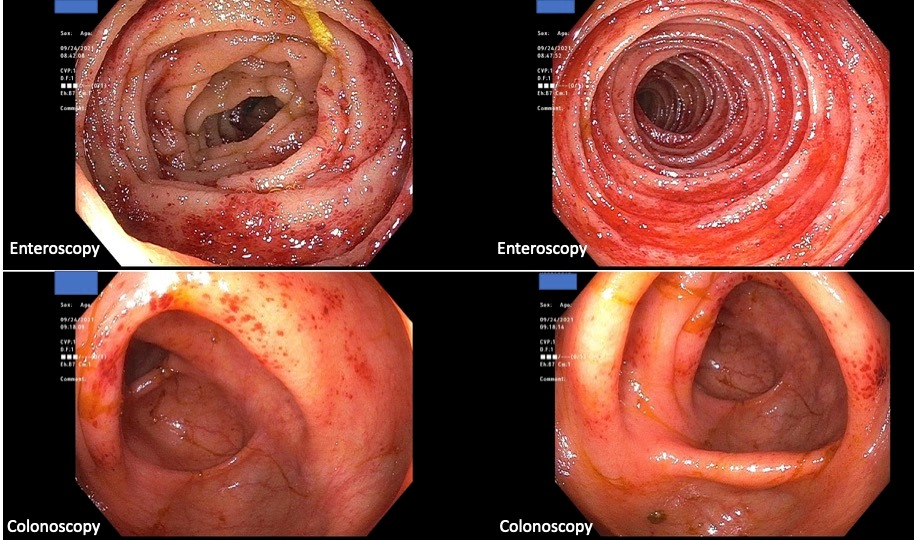Back
Poster Session E - Tuesday Afternoon
E0663 - Amyloidosis Diagnosed by the GI Doctor
Tuesday, October 25, 2022
3:00 PM – 5:00 PM ET
Location: Crown Ballroom

Shany M. Quevedo, MD
Aventura Hospital & Medical Center
Miami Lakes, FL
Presenting Author(s)
Arash Zarrin, DO1, Shany M. Quevedo, MD2, Steven Kaplan, MD3, Ifrah Butt, MD1
1HCA Florida Aventura Hospital, Aventura, FL; 2Aventura Hospital & Medical Center, Miami Lakes, FL; 3Aventura Hospital & Medical Center, Aventura, FL
Introduction: Amyloid light-chain (AL) amyloidosis is the most common form of amyloidosis and is the main type to involve the gastrointestinal tract. Monoclonal Gammopathy of Undetermined Significance (MGUS) is a Plasma Cell Dyscrasia (PCD) with potential to precipitate amyloidosis. Our patient presented with a constellation of signs and symptoms that lead to his diagnosis.
Case Description/Methods: A 59-year-old man with a history of Hemoglobin S-C presented with recurrent admissions to our hospital for new-onset orthostasis, weight loss, and dyspnea progressing over a 9 month period. Physical exam was unimpressive at the first presentation. Labs were significant for a NT-Pro BNP of 17,100 pg/ml. Echocardiography and cardiac MRI showed a restrictive filling pattern with preserved ejection fraction, however a specific etiology was not identified. Serum immunofixation revealed monoclonal IgA light chain proliferation. Bone marrow biopsy confirmed MGUS. The patient later developed epigastric pain with associated chronic watery diarrhea, peripheral edema, and hypoalbuminemia. A CT demonstrated colonic wall thickening with trace abdominal ascites. Enteroscopy revealed severe inflammation of the duodenum and jejunum characterized by edema, friability, scalloping, and diffuse petechiae. Colonoscopy showed similar but patchy involvement throughout. Histology was initially inconclusive. However, our suspicion remained high so slides were sent to a GI specialty lab. Pathology ultimately demonstrated immunoglobulin light chain lambda amyloidosis. He developed nephrosis as well. A work-up for autoimmune, infectious, and malignant causes was negative. The patient was ultimately transferred to a nearby hospital with specialty care services.
Discussion: AL amyloidosis develops as a result of monoclonal light chain deposition in various tissues. The cardiac and renal systems are most commonly involved. The main causes include PCDs and autoimmune illnesses. The diagnosis is often delayed. It should be suspected in a patient who presents with restrictive cardiomyopathy or otherwise unexplained heart failure. Our patient’s illness manifested as restrictive cardiomyopathy and likely protein losing enteropathy. MGUS can precede amyloidosis by about 12 years so this was an important finding. Initial GI biopsies were inconclusive but ultimately cinched the diagnosis, highlighting the importance of remaining skeptical. Treatment is aimed at the underlying cause.

Disclosures:
Arash Zarrin, DO1, Shany M. Quevedo, MD2, Steven Kaplan, MD3, Ifrah Butt, MD1. E0663 - Amyloidosis Diagnosed by the GI Doctor, ACG 2022 Annual Scientific Meeting Abstracts. Charlotte, NC: American College of Gastroenterology.
1HCA Florida Aventura Hospital, Aventura, FL; 2Aventura Hospital & Medical Center, Miami Lakes, FL; 3Aventura Hospital & Medical Center, Aventura, FL
Introduction: Amyloid light-chain (AL) amyloidosis is the most common form of amyloidosis and is the main type to involve the gastrointestinal tract. Monoclonal Gammopathy of Undetermined Significance (MGUS) is a Plasma Cell Dyscrasia (PCD) with potential to precipitate amyloidosis. Our patient presented with a constellation of signs and symptoms that lead to his diagnosis.
Case Description/Methods: A 59-year-old man with a history of Hemoglobin S-C presented with recurrent admissions to our hospital for new-onset orthostasis, weight loss, and dyspnea progressing over a 9 month period. Physical exam was unimpressive at the first presentation. Labs were significant for a NT-Pro BNP of 17,100 pg/ml. Echocardiography and cardiac MRI showed a restrictive filling pattern with preserved ejection fraction, however a specific etiology was not identified. Serum immunofixation revealed monoclonal IgA light chain proliferation. Bone marrow biopsy confirmed MGUS. The patient later developed epigastric pain with associated chronic watery diarrhea, peripheral edema, and hypoalbuminemia. A CT demonstrated colonic wall thickening with trace abdominal ascites. Enteroscopy revealed severe inflammation of the duodenum and jejunum characterized by edema, friability, scalloping, and diffuse petechiae. Colonoscopy showed similar but patchy involvement throughout. Histology was initially inconclusive. However, our suspicion remained high so slides were sent to a GI specialty lab. Pathology ultimately demonstrated immunoglobulin light chain lambda amyloidosis. He developed nephrosis as well. A work-up for autoimmune, infectious, and malignant causes was negative. The patient was ultimately transferred to a nearby hospital with specialty care services.
Discussion: AL amyloidosis develops as a result of monoclonal light chain deposition in various tissues. The cardiac and renal systems are most commonly involved. The main causes include PCDs and autoimmune illnesses. The diagnosis is often delayed. It should be suspected in a patient who presents with restrictive cardiomyopathy or otherwise unexplained heart failure. Our patient’s illness manifested as restrictive cardiomyopathy and likely protein losing enteropathy. MGUS can precede amyloidosis by about 12 years so this was an important finding. Initial GI biopsies were inconclusive but ultimately cinched the diagnosis, highlighting the importance of remaining skeptical. Treatment is aimed at the underlying cause.

Figure: Endoscopy Images
Disclosures:
Arash Zarrin indicated no relevant financial relationships.
Shany Quevedo indicated no relevant financial relationships.
Steven Kaplan indicated no relevant financial relationships.
Ifrah Butt indicated no relevant financial relationships.
Arash Zarrin, DO1, Shany M. Quevedo, MD2, Steven Kaplan, MD3, Ifrah Butt, MD1. E0663 - Amyloidosis Diagnosed by the GI Doctor, ACG 2022 Annual Scientific Meeting Abstracts. Charlotte, NC: American College of Gastroenterology.
